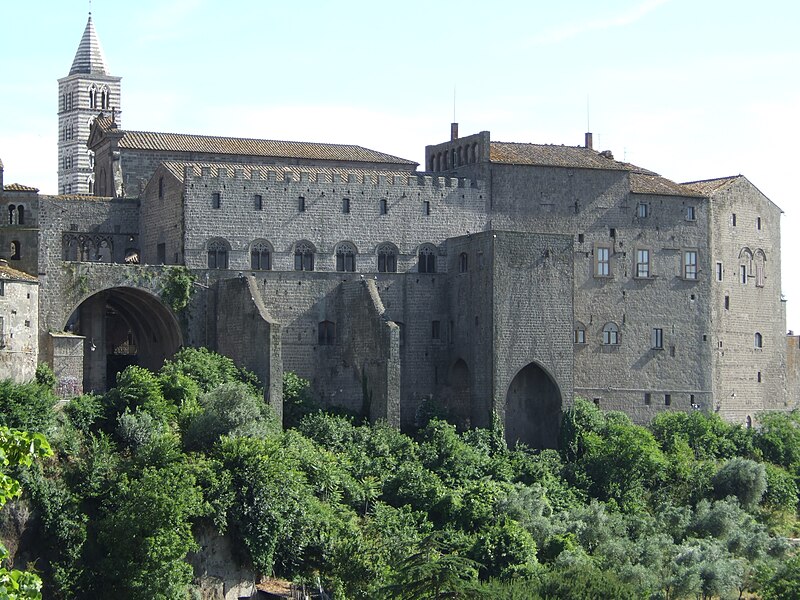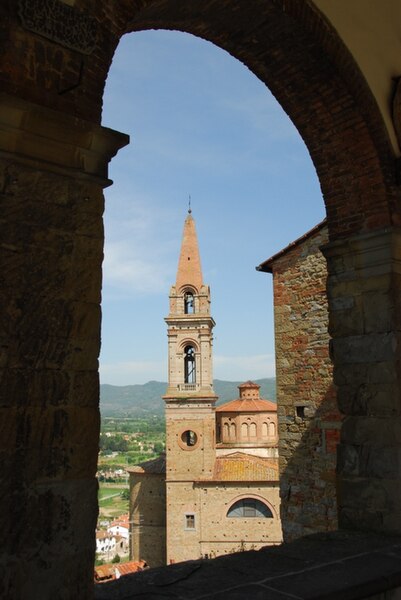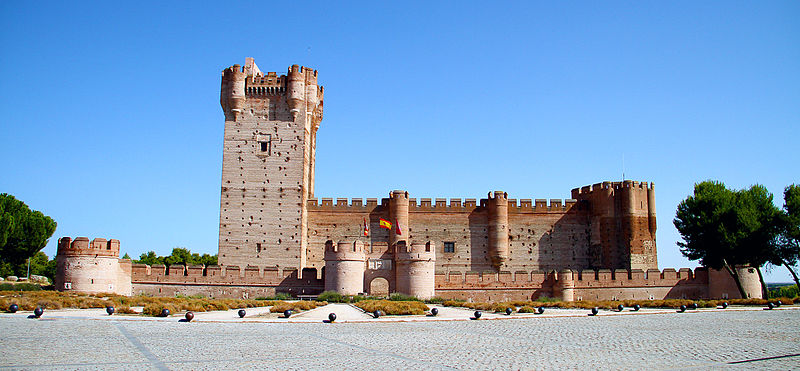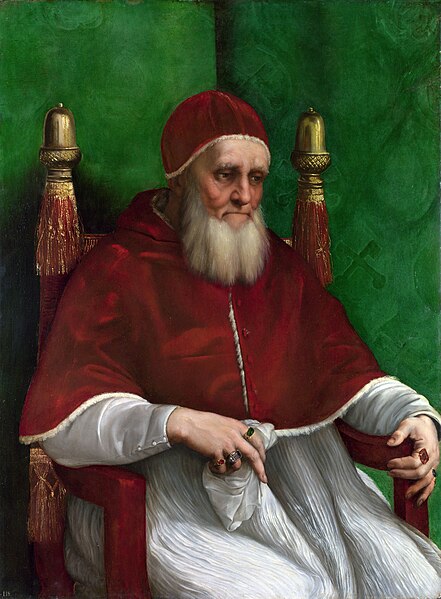 |
| Pope's Palace Viterbo |
Cesare
survived the death of his father, only to find that several cities had risen in
revolt and a French army under Francesco Gonzago had reached Viterbo, only forty miles from Rome. Cesare knew that his only hope of survival
was to stop the election of his bitter enemy della Rovere who was one of three
candidates; the other two were Cardinal Georges d’Amboise, Louis XII’s chief
counsellor and Cardinal Ascanio Sforza, released from prison by d’Amboise’s
order.
 |
| Pope Pius III |
The Orsini
stormed Cesare’s palace and Cesare took refuge in the Castel Sant’Angelo. Della
Rovere sent messengers to Cesare assuring him of his protection in the event of
his election. To block della Rovere Cesare used the monies taken from Rodrigo’s
apartments to help swing the papal conclave to choose a compromise candidate; Francesco Todeschini-Piccolomini who took the name of Pius III[i].
Pius lasted
twenty six days and the following conclave was short, della Rovere was elected with
Borgia assistance and took the name Julius II. The Venetian envoy commented of
Julius;
‘No-one has any influence
over him, and he consults few or none. It is almost impossible to describe how
strong and violent and difficult he is to manage….he inspires fear rather than
hatred, for there is nothing in him that is small or meanly selfish.’[ii]
Cesare left
the Castel Sant’Angelo and returned to his apartments at the Vatican. Julius
needed Cesare’s help. It’s surprising that Cesare believed accepted Julius’
promises, one who had long been an enemy of his family.
The Downfall of Cesare
 |
| Castiglione Fiorentino |
Florence’s
enemy Venice was helping herself to city after city in the Romagna. And as Venice
was Cesare’s ally, Machiavelli informed Cesare that Florence was not prepared
to allow him to travel through Florentine lands.
Florentine
soldiers disarmed much of Cesare’s army at Castiglione Fiorentino and captured Michelotto into the
bargain[iii]. Julius was jubilant
when he heard the news.
‘The pope was overjoyed,
more than words can say, and believed that the capture of this man offered an
opportunity to uncover all the cruel thefts, murders, desecrations, and other
countless evils that have been committed in the last eleven years in Rome.’[iv]
Not long
before Cesare had been arrested in Ostia while attempting to
escape to Genoa. Cesare was still refusing to hand over the few remaining
fortresses he controlled in the Romagna. He was brought back to Rome and
informed that Julius wanted all Cesare’s commands handed over, along with the
secret passwords that his Spanish commanders demanded before surrendering their
commands.
Cesare was
housed in an apartment in the Vatican reserved for visiting cardinals. Gian
Giordano Orsini[v]
urged Julius to kill Cesare. Machiavelli’s reports to Florence show Cesare was
now;
‘Inconstant, irresolute and
timid and not standing firm in any decision.’[vi]
But he did
not give his secrets up to Julius and his commanders continued in their refusal
to surrender the fortresses they commanded. By February Cesare was desperate to
earn his freedom and agreed to give up the passwords in return for the gold
held in his name in Genoa.
Cesare was
transferred to Ostia in February and was held captive for a further two months
while the slow process of the surrendering of the fortresses took place.
Lucrezia’s father-in-law was asked to proffer Cesare asylum in Ferrara; he
refused. Cesare was released and decided to go to Naples; his cousin Cardinal
Pedro Borgia, himself in Naples, sent Cesare a galley to bring him to a city
now under the control of Ferdinand of Spain.
The Twilight Years
 |
| Castel Nuovo, Naples |
Cesare spent
three weeks in Naples, planning his return to the Romagna. When he visited the
city’s commander, Gonzalo de Cordoba, to bid him farewell Cesare was stunned to
be arrested at the pope’s request. Cesare was imprisoned on the island of Ischia under increasingly punitive arrangements. On August 20th
Cesare was taken by galley to Spain and taken to a castle in Chinchilla.
Meanwhile
Lucrezia had raised enough money to fund 1,000 soldiers who were commanded by
Borgia loyalist Pedro Ramires. Discovering that Cesare was in prison Ramires
turned back. In January 1505 Lucrezia’s father-in-law died and she was now
duchess of Ferrara. She was looking after Cesare’s illegitimate children
Camilla and Giralomo, as well as Giovanni, the infans Romanus. Lucrezia
appointed Alberto Pio, Lord of Carpi as his guardian.
 |
| La Mota castle |
In the
spring of 1505 John III of Navarra, Cesare’s brother-in-law,
petitioned Louis for payment of the dowry Cesare had been promised when he
married Charlotte. The request was refused and shortly afterwards Cesare hurled
himself on the castle’s commander, apparently in an attempt to throw himself
off the ramparts. He was overpowered and shortly thereafter moved to the
fortress of La Mota at Medina del Campo, northwest of Madrid.
 |
| Juana la Loca |
Spanish
power politics now left Cesare under the control of Queen Juana[vii], rather than his inveterate enemy
Ferdinand. Juana had Cesare indicted with the murders of his brother Juan and
Lucrezia’s beloved Alfonso of Bisceglie[viii].
Ferdinand
was distracted by events in Naples and Juana was showing signs of the dementia
that was to plague her; discipline at La Mota slackened and Cesare was given assistance
in a bid to escape. On 25th October 1405 Cesare slid down a rope to
freedom. Injured in a fall when the rope was cut by above, Cesare was still
mounted on a horse and arrived in Navarre on 3rd
December, a semi-invalid. He was described as;
‘A man doubled up, with an
ugly face, a big nose, dark.’[ix]
In Navarre
he wrote to all and sundry in a desperate attempt to regain what he had lost.
Death of a Reputation
 |
| Julius II |
Julius II
was determined to destroy any vestige of the Borgias and, like a man obsessed,
ordered;
‘I will not live in the same
rooms as the Borgias lived. He desecrated the Holy Church as none before. He
usurped the papal power by the devil's aid, and I forbid under the pain of
excommunication anyone to speak or think of Borgia again. His name and memory
must be forgotten. It must be crossed out of every document and memorial. His
reign must be obliterated. All paintings made of the Borgias or for them must
be covered over with black crepe. All the tombs of the Borgias must be opened
and their bodies sent back to where they belong – to Spain.’[x]
His attempts
were doomed to failure. Despite the attempts of his enemies Cesare lived on and,
despite Julius’ attempts to erase the name Borgia, at least two of Rodrigo’s
successors considered Alexander VI as an exemplary pontiff.
Despite his
hatred of Rodrigo, Julius continued Rodrigo’s policy of expanding the Papal
States, albeit without Cesare. And this, the most war-like of popes, was to be
extremely successful at his self-ordained task. He also mirrored Rodrigo’s
nepotism.
Death of a Prince
Cesare died at
the age of thirty one on 12th March 1507, fighting for his wife’s
brother, John of Navarre. Cesare was besieging the castle at Viana held by the Count of Lerin. He arrived at Viana in December
1506 with 10,000 men.
In the early
morning of 11 March 1507 a number of Lerin’s knights escaped from the castle
during a heavy storm. Outraged
Cesare chased them outpacing his own men. Realising that Cesare was isolated
the knights trapped him in an ambush. Cesare received a fatal injury from a
spear. He was then stripped of all his luxurious garments, valuables and the
leather mask covering his face, Cesare was left lying naked, with just a red
tile covering his genitals.
Upon
receiving the news Lucrezia;
‘Did not cry but displayed
great sadness and great fortitude.’[xi]
King John
had Cesare buried in a marbled mausoleum he had ordered built by the altar of
the Church of Santa Maria in Viana.
Rodrigo’s Last Child
‘Celebrated with great joy
with church bells, salvoes of artillery and fireworks. All the screens and the
cloth in the windows of the piazza caught fire; in the court house the benches
of the notaries, the judge’s stand, the windows and the doors all burnt down as
well as the pews of the ladies in the cathedral.’[xii]
E
rcole was
followed on the 25th August 1509 by Ippolito. The following year Lucrezia met the
famed French soldier, the Chevalier Bayard while the latter was co-commanding the French allied
garrison of Ferrara. The Chevalier became a great admirer of Lucrezia's,
considering her a ‘pearl among women’.
 |
| Chevalier Bayard |
Lucrezia
suffered the loss of her beloved child Rodrigo who predeceased her, dying in
August 1512 at the age of 12. Two years later Lucrezia gave birth to Alessandro
and on 3rd July 1515 Leonora and on 1st November 1516
Francesco.
Lucrezia outlived
all her siblings, dying on 25th June 1519 at Ferrara. The death
followed complications after the birth of her eighth child Isabella Maria who
was born and died on 14th June. Lucrezia had a history of
problematic pregnancies; Lucrezia was buried in the convent of Corpus Domini.
Bibliography
At the Court
of the Borgia – Johan Burchard, Folio Society 1990
Lucrezia
Borgia – Rachel Erlanger, Michael Joseph 1979
The Borgias
– Mary Hollingsworth, Quercus Editions 2014
The Borgias
– GJ Meyer, Bantam 2013
A History of
Venice – John Julius Norwich, Penguin Books 1982
Absolute
Monarchs – John Julius Norwich, Random House 2011
The March of
Folly – Barbara Tuchman, Cardinal 1990
Niccolo’s
Smile – Maurizio Viroli, IB Tauris & Company Ltd 2001
www.wikipedia.en
[i]
Honouring his uncle Pius II
[ii]
Absolute Monarchs - Norwich
[iii]
Michelotto had been ferrying the Vatican gold to Ferrara
[iv]
Niccolo’s Smile - Viroli
[vi]
Ibid
[vii]
Later known as Juana the Mad
[viii]
She was probably influenced by Cesare’s son-in-law the dowager Duchess of
Gandia
[ix]
The Borgias - Meyer
[xi]
The Borgias - Hollingsworth
[xii]
Ibid
A tragic family trapped by the circumstances and ambitions demanded by the times.
ReplyDelete